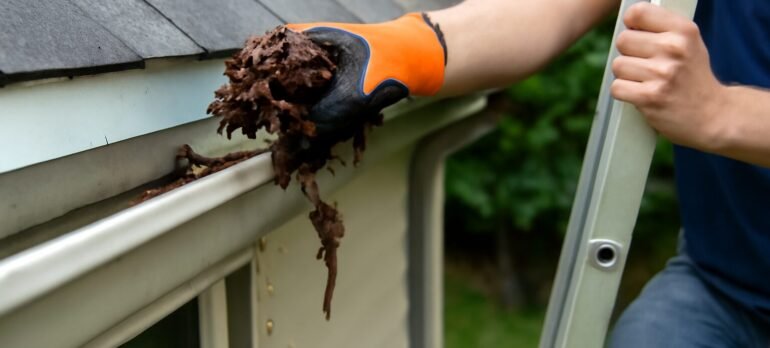
Gutter cleaning is more than just a household chore; it’s an essential part of maintaining the overall health of your home. Gutters are designed to direct rainwater away from your roof and foundation, but when they get clogged, that water has nowhere to go. If left unchecked, overflowing gutters can cause serious damage to your roof, walls, and foundation, leading to costly repairs.
In this guide, we’ll explain how often you should clean your gutters, what factors affect that timing, and how professional services can help keep your property safe.
What Affects How Often You Should Clean Gutters?
The frequency of gutter cleaning depends on several factors related to your property’s surroundings and the weather patterns in your area.
- Tree Coverage: If your home is near trees, especially those that shed leaves in autumn, your gutters will fill up quickly and require more frequent cleaning.
- Storm Frequency: Areas that experience heavy rainfall or strong winds can have debris carried onto the roof, increasing the chances of clogged gutters.
- Gutter Age and Material: Older gutters or those made of lower-quality materials are more prone to collecting debris and may require more maintenance.
For those looking to avoid regular maintenance issues, professional gutter cleaning services can help protect your home year-round.
How Often Should You Clean Your Gutters?
For most homes, a cleaning schedule of twice a year is recommended. This should occur once in late summer, before autumn leaves begin to fall, and once after the winter storms have passed. However, homes that are surrounded by trees or live in areas prone to heavy storms may need a more frequent schedule, every 3 to 4 months.
After major storms, it’s a good idea to inspect your gutters for any potential blockages or overflow. A twice-yearly cleaning schedule can reduce the risk of gutter-related water damage by up to 40%.
Signs It’s Time to Clean Before the Next Scheduled Visit
Even if you stick to a regular cleaning schedule, gutters can fill up faster than expected. Here are some warning signs that it may be time for an early cleaning:
- Water spilling over the edges during rainfall
- Visible leaves or plants growing in the gutters
- Sagging or detached gutter sections
- Damp patches on walls near the roofline
By addressing these issues early, you can avoid increasing your risk of water damage, which could grow by 50% over time if neglected.
The Cost of Not Cleaning Your Gutters
Delaying gutter cleaning may lead to far more expensive repairs later. Blocked gutters can cause water to leak under your roof, damage wooden structures, and even weaken your home’s foundation.
Neglecting this important maintenance task can increase repair costs by up to 5 times, especially when foundation or structural repairs are required. To avoid these costly risks, it’s best to stay on top of scheduled gutter maintenance. Consider investing in regular roof maintenance services to prevent future damage and extend the lifespan of your roof.
DIY vs. Professional Gutter Cleaning
While some homeowners may attempt to clean their gutters themselves, it’s important to consider the pros and cons of DIY versus hiring a professional. If you have a single-storey home, a stable ladder, and are comfortable working at heights, DIY cleaning is possible. Just be sure to wear gloves, check for any damage, and flush the downpipes to ensure proper water flow.
However, professional cleaning is safer, faster, and more thorough. Experts can spot early signs of wear, remove stubborn debris, and handle multi-storey homes with ease. For a thorough clean, relying on professionals to handle the job can provide greater peace of mind. You may also want to look into roof restoration services to ensure your roof is in the best condition.
How to Reduce the Need for Frequent Cleaning
If you’d prefer not to clean your gutters as often, there are several strategies you can use to reduce buildup and prevent future blockages:
- Install gutter guards: These prevent leaves and debris from entering your gutters, reducing the frequency of cleaning required.
- Trim overhanging trees: Regular trimming helps minimise the number of leaves and branches that end up in your gutters.
- Check after storms: Make a habit of inspecting your gutters after storms to catch issues before they escalate.
By taking these steps, you can prolong the time between cleanings and reduce the risk of blockages.
Conclusion
Gutter cleaning is a crucial part of home maintenance, ensuring that rainwater is properly directed away from your property. By adhering to a regular cleaning schedule and addressing issues early, you can protect your home’s roof, walls, and foundation from water damage.
Investing in regular professional services will help maintain your gutters’ efficiency year-round and prevent costly repairs down the line. Contact Quik Solutions today to ensure your gutters are always in top condition!


